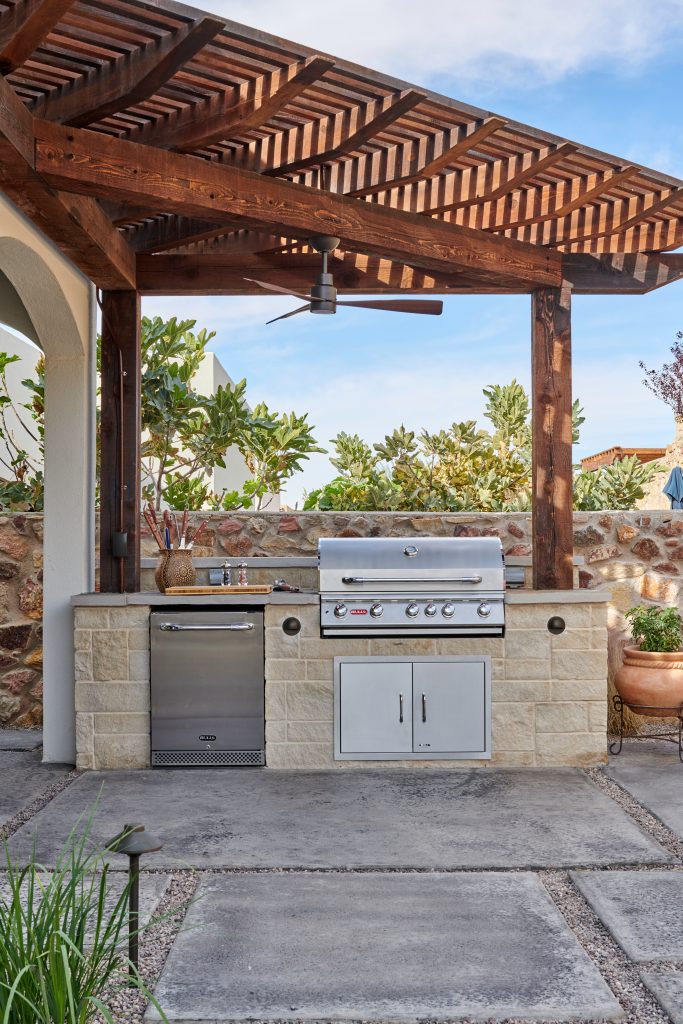So, you’ve been thinking about adding an outdoor kitchen to your backyard… because who doesn’t enjoy a nice cookout, and there’s just something about how good the food is when it’s made and eaten outside. We know it can be a little overwhelming thinking about what to add, what design is best and how much of a kitchen you want, etc. There’s just so much that can come with an outdoor kitchen so let’s break it down…
Now, what creates the outdoor kitchen space is comprised of different areas. Similar to what you’d find in an indoor kitchen you have your prepping area and cooking area curated to your liking.
The cooking zone would typically be the focal point in your outdoor kitchen since that’s where the magic happens. This would consist of your grill, pizza ovens, smokers, ice makers, dishwashers or whatever you prefer along with storage units for utensils and safe/easy access to gas lines. Following the cooking area is the prep zone which should be about 3ft in length to give you enough room to prep food and plates, as well as for safe movement. As mentioned before, space is a big deal, and should there be enough room you might have a third area, the bar area. There are a few different layouts to choose from when designing your outdoor kitchen; Linear, Parallel, L-Shaped, U-Shaped and the most popular being custom. No matter which layout you choose, the most important thing is to establish what would still be a natural flow for whatever design you choose, so space is important. You might see many kitchens placed right outside the back door, across/parallel from the house and this is where we don’t want to put them. Although it may seem the most convenient it really becomes a bit more of an obstruction rather than an accommodation or addition. First and foremost, “Safety” is the number one factor for addition placement. This should allow for clear view of children playing or while in pools and if your kitchen is right outside your door, that view is then obstructed.
Now that we have a better understanding of what composes an outdoor kitchen or determines its layout.
Let’s look at the different design options…
LINEAR
Linear is probably the most common kitchen style, typically due to space and it being favored for its functionality. These outdoor kitchens are an easy and simple setup. They’re perfect for smaller spaces and can either run alongside the house or be built freestanding with the grill set in the middle with two spaces on the side allowing enough space to work with and prepare food. With this little kitchen you can also add a fridge and even pair it with a separate outdoor dining area nearby for all to sit and enjoy.
PARALLEL
A second option would be parallel, the parallel layout is best described as two islands horizontal to each other with one containing the grill; this particular set up can also be referred to as ‘Galley Islands’. Think of it almost like a bar setting: The open island area with the grill allows for multiple people to be “in the kitchen” cooking while the other side can double as a serving and entertainment space. There are two different styles, the buffet and bar. The buffet style sits at about 32 inches more like a traditional dining room table level whereas the bar style is more elevated, standing at about 42 inches.
L-SHAPED & U-SHAPE
The L-Shaped outdoor kitchen may be the most popular layout. With an L-Shaped kitchen you can have multiple components, for example, griddles and smokers. Not only are you able to add more components, but this open style gives the space a much larger appearance and feel. Of course, the L Shaped design doesn’t have to be filled with extras, it can be a simple grill and sink area with an extended seating area next to you allowing your guests and loved ones to be around and chat whilst you cook. If you’re limited on space, an L-Shaped kitchen is still great for functionality rather than just additional seating.
The same goes for the U-Shape, however it is much bigger than an L-Shaped kitchen and most popular for larger outdoor spaces and gatherings. This is mostly used to provide a large serving area both to the right and the left of the U with the grill stationed in the middle. It’s both functional and spacious but accommodates for additional seating and interaction in an open setting.
CUSTOM
Lastly, there’s custom, our most popular installment. This is a combination of each option,
personalized and arranged according to the clients wants and needs all while ensuring a safe and
functional space. There are four key factors that are put in to place to guarantee the best outdoor
kitchen addition for our client’s homes: Architecture, Scale, Functionality and Safety. Each of
these determine different aspects of the kitchen or any other addition for that matter. Architecture
follows the style of the home and thus follows through to the outdoor space allowing consistent
visual flow from the indoors to the outdoors. Scale and Functionality work hand in hand, scale
dictates the proportions of the space and determines the best layout for size and functionality.
One should always aim to have ample workspace and an addition that is neither to large nor too
small for the area. Last, but not least, Safety, the number one factor. As mentioned earlier, your
view of open spaces especially where children may be playing should never be obstructed and of
course your outdoor kitchen should never feel cramped.

